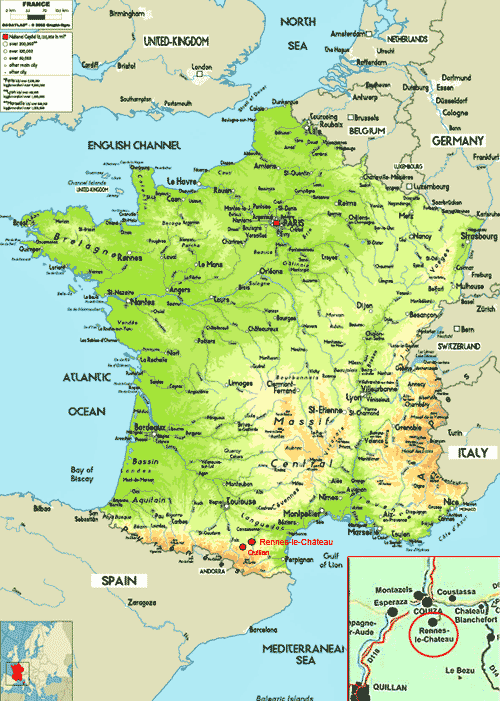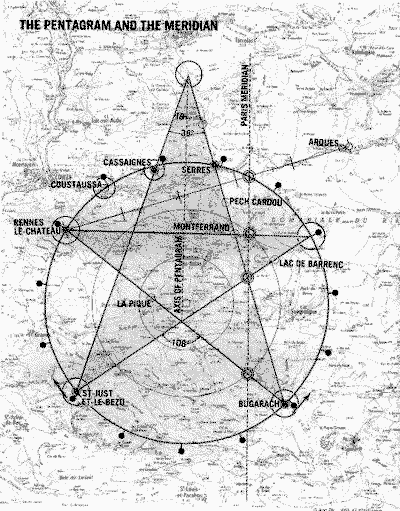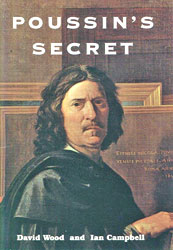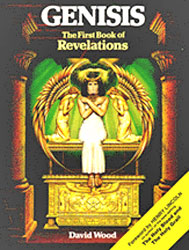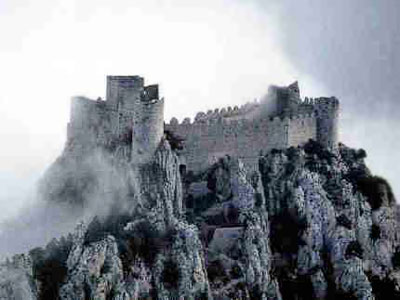|
|
|
from Section4 Website recovered through WayBackMachine Website
The Mysterious Village
Located on a 1,500 foot hill above the twin villages of Couiza and Montazels it remains out of sight to all but the discerning eye.
And yet it is not a town where nothing ever happens, for over at least the past two thousand years, the site of Rennes-le-Château has attracted Celts, Romans, Visigoths and Merovingians, Cathars and Knights Templar, all of which have added to its seductive qualities.
Rennes-le-Château, now, at the end of the second millennium is easy
to reach by most forms of modern transport, but a hundred or more
years ago the journey by foot or mule was an arduous one and whilst
the village inhabitants, using their semi-secret sheep tracks could
probably have made ascent or descent within 30 or 40 minutes, the
modern traveler will need at least an hour and will suffer the
consequences of his labour.
Interlopers could be detected when they were many miles away, the location being ideal from a defensive military point of view. It should come as little surprise therefore, to discover that according to some historians, the village used to be the centre of the Visigothic kingdom of the Razès.
Indeed, the
church at the centre of the mystery, St. Mary Magdalene is built on Visigothic foundations that date back to the 4th - 6th centuries AD.
The agents of the massacre were an army of some 30,000 knights and foot-soldiers from Northern Europe.
Their victims: almost the entire 'Cathari' or Albigensian population of the Languedoc region of what is today southern France.
At that time it
was a peaceful and cultivated population of independent people whose
only crime seems to have been that it followed a religious way of
life contrary to the one decreed by Rome.
With that
transformation came anonymity and so things remained for 600 years
until the end of the last century.
At the time, the ancient church was in sad need of expensive restoration but the impoverished priest lacked the necessary money to make the repairs.
Eventually, in 1891, a small loan was arranged and during the subsequent work the altar was dismantled. Inside one of the hollow altar pillars were found documents, genealogical charts and Latin texts of codes so complex that it is surprising that they were ever decoded.
The key to their solution however was found engraved on a tombstone in the church's cemetery. It read:
Another extract, possibly more direct in its meaning read:
Shortly after his discovery, the priest went to Paris and showed the coded parchments to the specialists at St. Sulpice.
When he returned to the village he brought with him reproductions of three paintings, one of which is now known to have been Poussin's Les bergers d'Arcadie which strongly resembles a location in a valley near to Rennes-le-Château.
A little while later, Bérenger Saunière started to spend prodigious quantities of money.
What had he discovered ?
It is said that 9 knights established the order to protect Christian pilgrims on their journeys to the Holy Land. For 9 years, they permitted no new members to join but their popularity and power grew rapidly during the 12th and 13th centuries following the success of the early crusades.
The Templars acquired property and land wherever they travelled and they were particularly wealthy in France. However, they were not controlled by the kings of the countries in which they lived but were accountable only to the Pope.
Less
obviously, they were dedicated to the Patriarchy of Constantinople,
a body that was not on the best of terms with Rome.
Therefore he
infiltrated spies into the Templar ranks and collected tales from
them of homosexuality, denials of Christ, spitting on the cross
etc., enough to cause the Pope to turn on the Templars.
Happenstance that the only Knights Templar to escape the
dawn raids were those of le Bézu commanderie which is visible from
Rennes-le-Château.
He noticed that the shepherds staves were cut neatly in half in their different positions in the painting.
He wondered whether it was by accident or design and also, if an x-ray examination of the original painting might reveal whether the staves had been painted first, before the background, or afterwards.
A visit to the Louvre and an inspection of the x-rays somewhat disappointed him for they revealed that Poussin had not changed his mind and disguised the mountain background by overpainting some of it as cloud.
However,
the encounter with the painting did cause him to wonder if anything
else was contained in the painting and he engaged an art historian
professor Christopher Cornford to make a detailed examination.
Lincoln wondered if the pentagon design might be represented in the countryside surrounding Rennes-le-Château, but lacked the surveying and mathematical discipline to tackle it.
Fortunately, an ex-army trained trig surveyor named David Wood had also had a similar thought about there possibly being a pentagon design in the landscape, as a result of seeing Lincoln's television programs.
Wood re-surveyed the area and established that most salient points like the ancient churches were exactly positioned as stated by the French IGN, and then proceeded to examine the mapping with an expert's eye.
After considerable effort, Wood discovered that there were several lines on the map, each marked with several markers and joined to make 36° on the points.
He next sought to find the circle that controlled them and eventually found that it passed through the ancient churches of Rennes-le-Château, Coustaussa, Serres, Bugarach and St. Just-et-le-Bézu. (click above image)
Additionally, the circle passed through the château at Serres and the strange rock formation at Les Toustounnes.
Statistically, with the lack of these classes of markers in the area, Wood knew that he was on to something very important and published his research in Genisis - The First Book of Revelations.
However, some of the churches could be dated back to Romanesque or Visigothic times which far pre-dated anything the Templars might have done, and so the mystery deepened.
Later, it
transpired that both the Poussin painting and the landscape carry
the same design which raises the question of,how did Poussin know ?
More importantly, was this part of Poussin's own work or did he
create Les bergers d'Arcadie according to someone's precise
instructions?
Since this claim was made in the French work Le Trésor Maudit by Gerard de Sède, allegations have been made by various researchers that the coded parchments were fabricated in the earlier part of this century by certain people.
What is fairly certain, is that the decoding of the alleged parchments could not have been made without the knowledge of the very sophisticated key that unlocks their secret.
What is uncertain, is that whether the original coded parchments were so discovered, copied and lost - in which case the ones referred to by de Sède whilst not being the originals could be facsimiles of them and still, therefore important or were they mere fabrications, intended to mislead.
The final answer must lie with
the reader.
Poussin was a fairly prolific painter and created many works divided between two principal themes - those taken from the scriptures and those dedicated to the works of the god Pan, representative of the natural world of the pagan.
The canvas Les bergers d'Arcadie belongs without doubt to the latter, referring the viewer to the Elysian fields of ancient Greece. A recent commentary by Henry de Lens actually states that the painting is an allusion to Virgil and one must again let the reader make up his own mind on this matter.
What is important is that the idea of depicting a tomb, sometimes adorned with a skull and the legend Et in arcadia ego is not the sole province of Poussin and was a somewhat popular theme amongst classical artists.
The legend itself
has been described by various authors as "bad Latin" and is loosely
translated as "even in death, I am there" although another anagrammatical translation is "behold I conceal the secrets of god".
The first is that a tomb, uncannily resembling the one in the painting was found near to Rennes-le-Château earlier this century - it has now been destroyed. Secondly, the garden at Shugborough Hall carries a reversed bas-relief of a version of Les bergers d'Arcadie with another mysterious legend above it.
For a detailed summary see Poussin's Secret or Genisis or Geneset.
click above images
That he escaped the wrath of Rome for painting such heretical, non-Christian pictures is a testament to his genius. Les bergers d'Arcadie falls into this category.
However, several other of Poussin's paintings, especially those that make up the quartet known as the Four Seasons, again depict biblical scenes and are housed underneath the glass pyramid in the courtyard of the Louvre museum in Paris.
It is possible that the world will
never know the exact involvement of Poussin with the mystery of Rennes-le-Château, but Poussin and his pictures keep re-entering the
mystery, (see Genisis, Geneset and Poussin's Secret
- click above images).
And yet what is a meridian?
Merely an arbitrary line that connects the Earth's north
and south poles together - it is an invention of Man and there are
an infinite number of them bounding the globe.
When was it established?
This is so far unknown - we know, for example that by the time that the church of St. Sulpice was built, that its position was chosen because the meridian ran through it. We also know that the French built their national observatory likewise upon the same meridian.
It is a pity really, that these two meridians are not the same and that there are many meters between the two - but that is not to say they weren't trying to be accurate, just that there was a battle between Church and State and that they both thought that they had the right position.
So, what were they trying to do?
The few historical details that can be gleaned mention that they were trying to recover the meridian from a marker that lay many kilometers to the south of Paris and it is probable that they tried to trace the same meridian from the marker to the city by taking star fixes with inferior equipment.
If this was the case, then they
did a remarkably accurate job because their inaccuracy was not
exposed until the national survey of France at the end of the 18th
century revealed it.
Therefore, the whole idea of a society from before those times having the ability to accurately mark out the landscape with the precision of the geometry discovered in the area of Rennes-le-Château is quite ludicrous.
And yet the geometrical design is there and it is locked together by the 0° meridian of Paris.
There are few theories which could give a reasonable explanation for the conundrum - either the 0° meridian of St. Sulpice is correct (the Rose Line) or the meridian of the observatory takes the honor or neither of them is correct.
What must be considered however, is that the
rumor
is true, that a very important marker lay far to the south of Paris
and that it is its meridian that is important.
We know of several ancient societies that did so, the Romans being just one of them. They marked every town or village with lines that ran north to south and others that ran east to west and their reason for doing so was to divide up the land for the purposes of levying their ancient tithes, (tenths that became tax see Geneset).
Are the markers of the geometry that old? Well some of the churches (markers) in the area are of Romanesque design which places them in the first few centuries of the first millennium. So what did the meridian mark and is the marker still there?
This is a profound question. It is possible that something was brought to the area in ancient times and that its north - south alignment was noted but its east - west alignment has disappeared. As this meridian stretches from the Pyrennees in the south to Dunkerque in the north it leaves plenty of scope for the Rennologist - unless he/she possesses the east - west alignment.
So what could the secret be? Here we enter the realm of fantasy. Hundreds of books have been written about Rennes-le-Château and most have speculated upon the 'treasure'. Factually we know little.
Several treasures have disappeared in the area surrounding Rennes-le-Château - possibly the treasure of the Temple of Solomon, brought to Carcassonne, 28 miles to the north, by the Visigoths and possibly concealed near Montségur (below image).
This is almost certainly the origin of the film Raiders of the Lost Ark where the Harrison Ford character was probably, in reality, Otto Rahn, (see Geneset or The Emerald Cup).
It is also known that the Romans mined silver and gold in the area so that is another possible source of treasure stories.
Add to that stories of the Merovingians who have connections to the area and the Knights Templar whose occupants at le Bézu, a stone's throw from Rennes-le-Château were allegedly the only ones not arrested in 1307 and we can see endless possibilities.
All that is certain is that the landscape geometry is there.
At a recent symposium on the subject, Henry Lincoln, co-author of the world best seller Holy Blood, Holy Grail, admonished his audience to "believe nothing I say" and that as far as he was concerned, the only part of the Rennes affair that could be proved, was the geometry which was a matter of fact and did not require 'belief'.
|


